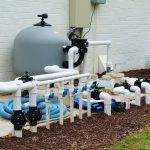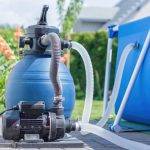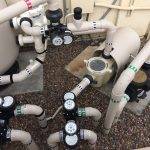Purchasing a pool pump can often be
For example, a 2 HP pump will produce only 15% more flow rate than a 1 HP pump but consume twice the energy for a given plumbing system. That is a lot more to pay for every month while not getting much in return. However, with a little bit of knowledge of pumps and plumbing, the pool owner has the tools necessary to choose what is best for his or her own pool.
Pool pumps come in two ratings; full rated and up-rated which is sometimes called max rated. The only real difference between these types of pumps is how the pump is labeled in terms of horse power (HP). Manufactures will sometimes sell identical pumps in full rated and up-rated versions. The full rated version will have a lower HP but a larger service factor (SF) while the up rated version will have a higher HP but a lower SF.
Service factors determine how far over the rated or labeled HP the electric motor can be driven. Most pool pumps today are used at close to full load which is sometimes called braking HP, service factor HP, or operating HP and can be calculated by multiplying the labeled HP by the service factor. So a full rated 1 HP pump with a service factor of 1.5 would have a braking HP of 1.5 and would be identical to an up-rated 1.5 HP with a service factor of 1. Both pumps will have the same pumping capability and provide the same flow rates for a given plumbing system. This is one of the most confusing aspects of pump ratings.
Besides the pump ratings, pumps can also be purchased as single speed, two speed and variable speed. Having additional speeds has advantages for pools with multiple flow rate requirements. Higher speeds can be used for spa jets, water features, rapid filtering, better skimming, and pool cleaners while lower speeds are useful for general filtering and circulation.
The primary benefit of multi-speed pumps is that they cost much less to run at lower speeds than at higher speeds. A two speed pump will use approximately 1/3 of the energy on low speed versus high speed. However, to get the same filtering of the water, the pump needs to be run twice as long on low versus high but that still saves over 33% in energy. Variable speed pumps can have even more savings for lower speeds.
Although a single multi-speed pump can often be used for pool filtering, spa jets and/or waterfalls, it is not always the best option. With only one pump, there is usually not enough flow to operate multiple features at the same time and/or the heated water of the spa needs to be isolated from the rest of the pool. Also sending high flow rates through the filter will reduce the life of the filter and reduce its filtering efficiency. So to get the best performance for spa jets, waterfalls and other high flow water features, it is usually a good idea to dedicate a high HP pump to each function. Also, with a separate pump for the spa jets, spa filtering and heating can still be accomplished with the pool filter pump and appropriate valve plumbing.
Spa jets will have much higher pump HP requirements than pool filtering and will usually require at least 15 GPM per jet or roughly 1/3 HP per jet. For spas with a large number of jets, it may not be possible to get a pump with high enough HP so using multiple pumps separated into jet zones is a good option.
As for circulation and filtering, larger pools will usually require larger HP pumps than smaller pools. However, average sized residential pools generally do not require more than a 3/4 HP pump for decent filtering. The following full rated pumps will give an 8 hr turnover for a specified pool size and typical plumbing setup.
| HP | SFHP | BEP GPM | BEP Head | Pool Volume (8hr Turnover) |
| 0.5 | 1.05 | 62 | 37 | 29,616 |
| 0.75 | 1.39 | 67 | 51 | 32,168 |
| 1 | 1.85 | 85 | 58 | 40,850 |
| 1.5 | 2.40 | 102 | 59 | 48,965 |
| 2 | 2.70 | 121 | 61 | 57,893 |
| 3 | 4.80 | 148 | 76 | 70,804 |
© TroubleFreePool.com 2014





